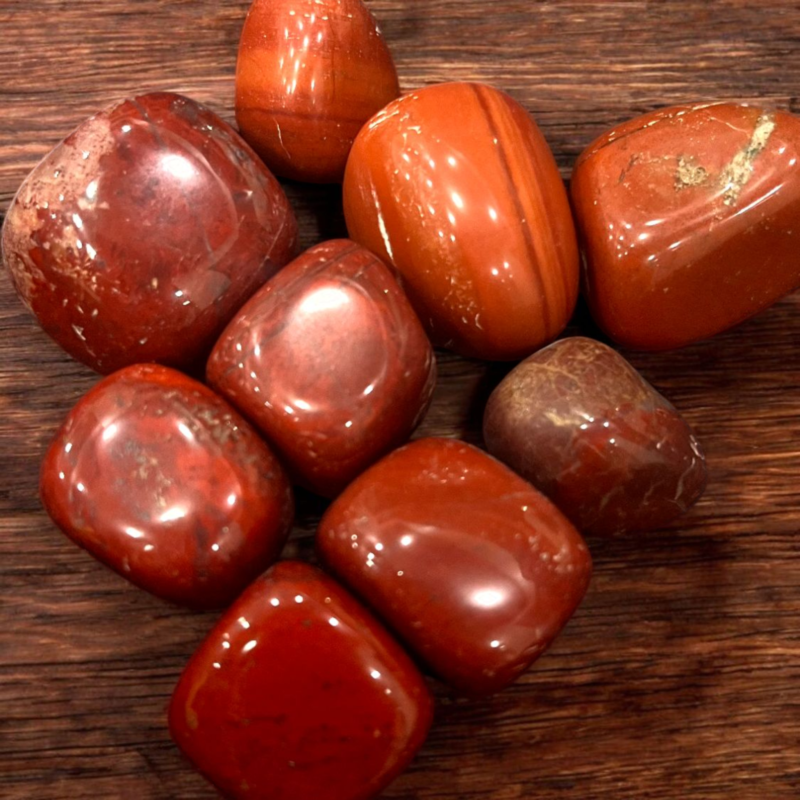What Makes Red Jasper So Special
Red Jasper is revered as a stone of endurance, grounding, and protection. Known for its rich earthy red hues, it has been used for centuries in rituals, tools, and jewelry. Because of its popularity and affordable appeal, Red Jasper is sometimes faked using dyed stones or composites. Here’s how to confidently identify real Red Jasper.
Observe the Clarity and Inclusions
Genuine Jasper Has Natural Variations
Real Red Jasper usually has a deep brick-red color with veins, spots, or streaks of brown, black, or white. These natural imperfections and patterns make each piece unique.
Solid Color with No Variation? Be Cautious
Fake or dyed stones often have an unnatural, overly bright red color without any streaks or inclusions. If the red looks too uniform or artificial, it may be dyed quartz or another stone.
Check the Feel and Weight
Jasper Is Dense and Earthy
Real Red Jasper feels solid, cool, and heavier than it looks. It is a dense microcrystalline variety of quartz.
Feels Light or Waxy? It Might Be Fake
If the stone feels too light, warm to the touch quickly, or has a plasticky surface, it may be resin, dyed agate, or even plastic.
Use the Scratch Test
Jasper Is Hard—Around 6.5–7 on the Mohs Scale
Gently try scratching the surface with a coin or knife. Real Red Jasper will resist scratches. Avoid aggressive testing on polished or finished surfaces.
Dyed Stones or Composites May Scratch Easily
Fake stones, especially those made with resin or soft minerals, will show wear or flake under light pressure.
Look at the Surface Closely
Jasper Has a Matte to Slightly Glossy Finish
Even when polished, authentic Jasper has a natural texture—more matte than glassy. It doesn’t shine like polished glass or plastic.
High Gloss or Plastic Shine Is a Red Flag
Too much shine, smoothness, or a waxy appearance might indicate a synthetic or dyed product.
Test With Light and Magnification
Hold It Under Strong Light
Real Jasper will show opaque or semi-opaque qualities, with depth and texture inside. It may also reveal layered structures or fine grains.
Use a Loupe or Magnifier
Look for dye concentrations around cracks or holes. This is a sign the color may have been added artificially. Genuine Jasper will not have color bleeding or bubbles.
Know the Shape and Formation
Jasper Doesn’t Grow in Crystals
Unlike quartz, Red Jasper forms in massive formations, not crystal points. It’s usually cut and polished into cabochons, beads, or figurines.
Uniform Beads? Look Closely
In mass-produced jewelry, fake Jasper beads are often dyed and too uniform in size, shape, and color. Natural Jasper will always vary slightly.
Ask the Right Questions Before Buying
Ask Where It Was Sourced
Authentic Red Jasper comes from India, Brazil, South Africa, and the USA. Reputable sellers should know the origin of their stones.
Check for Certifications or Honest Descriptions
If a seller is transparent about whether their stone is dyed, reconstituted, or natural, it builds trust. Lack of information can be a warning sign.
Common Imitations of Red Jasper
Dyed Quartz or Agate
Often used because of their similarity in hardness, but look overly vivid or consistent in color. Can fade over time if exposed to water or sunlight.
Resin or Glass
Lightweight and glossy, these fakes may mimic the color but lack the density, texture, and energy of real Red Jasper.
Final Thoughts
Identifying real Red Jasper involves checking its natural color variations, solid weight, slight surface texture, and origin. Trust your senses—especially touch and sight—and always buy from trusted sellers.
With a little practice, spotting genuine Red Jasper becomes an easy and enjoyable process.


